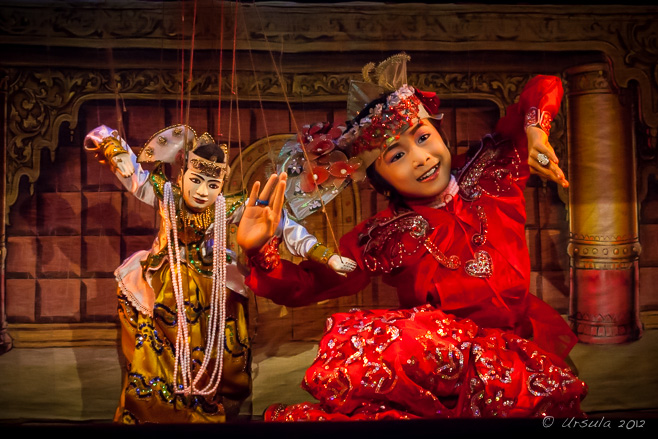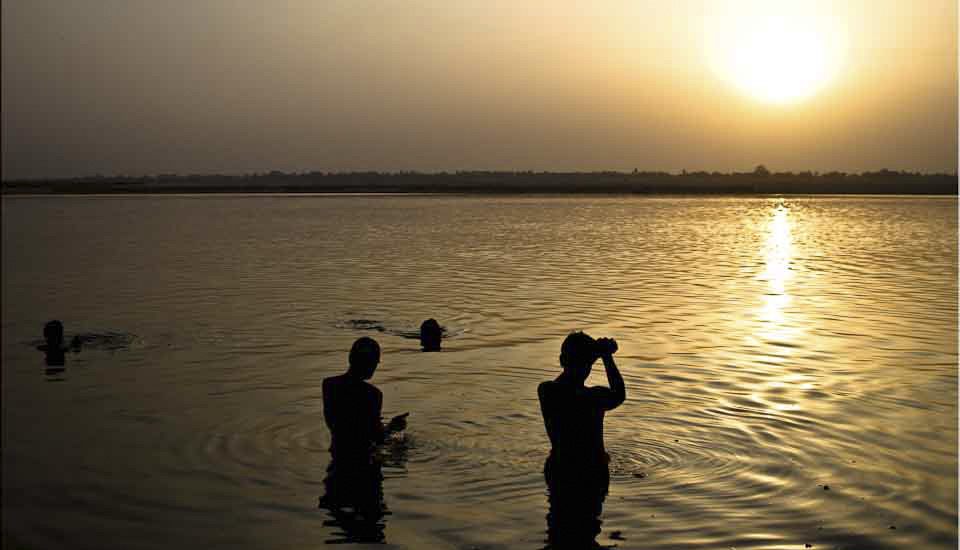
Battle of the Marionettes
Life imitates art at the Mandalay Marionettes Theatre.
It was hot. And dark. And – unless you enjoy clanging discordant pentatonic music – noisy.
It was almost time for the evening performance at the Mandalay Marionettes Theatre. As we filed into the tiny space, a small band played Burmese classics to welcome us.

Welcome Music
The Mandalay Yoke-Soun-Thabin Band plays the musical prelude.

Marionettes for Sale
While waiting for the performance, I amused myself by examining the marionettes on the walls.

Saung – Traditional Burmese Harp
The sounds of the saung were much more to my musical tastes! It’s a boat-shaped, sixteen-stringed harp made from padauk (pterocarpus) wood, acia catechu wood, and deerskin.

No Strings!
The first act is a traditional burmese dance –

Burmese Dancer
– performed by a beautiful young child.

The White Horse
According to myth, the Himalayan Range was home to many animals and demons. The horse’s head is the first constellation in Buddhist cosmology.

Monkey King
As anyone who has watched the classic Japanese children’s show Saiyūki, or Monkey Magic, knows, the monkey king is ever-present in Buddhist stories –

Himalayan Scene
– and, amid the crashing and banging of cymbals and gongs, there is bound to be a battle.

Belu Demons Battle Scene
Whew! We have a victor!

Zaw-Gyi, the Alchemist
Another popular traditional character, the Zaw-Gyi, is a demigod who lives in the forest.

Comical Dance
Portraying two popular rural villagers, an old bachelor and an old spinster, this was meant to be a humorous and romantic dance. Truthfully, except for the costumes, I couldn’t tell the difference!

“Anything you can do…”
A marionette watches while a child takes its turn at the dance. I was amused that the child, too, had a puppet-master.

Puppet Master

The Prince and Princess
The last piece, about a prince coming home from his studies and introducing his intended to his family, is considered “the most beautiful and sentimental performance”. (Fortunately, we were given programmes; I would never have deduced the story otherwise!)

Enter the Clowns
The Prince and Princess are flanked by clowns who are meant to entertain them. The back curtain is raised again, allowing us to watch the puppet masters at work.

Watching the Puppet Master
Elderly Puppet Master U Pan Aye clearly takes joy in the dance his Prince is performing.

Female Puppet Master
Soon, it is the turn of the protege to operate her Princess.

Puppet Master U Pan Aye
After the performance, the Puppet Master comes out to meet the small audience, smiling with pride at our pleasure in his show.
Yoke Thay, traditional Myanmar puppet theatre, dates back several centuries. It was entertainment, held in high esteem by royalty, but also served to communicate news, stories, and moral lessons to everyone. Today, with more modern entertainments readily available, traditional marionette performances are a dying art.
This small troupe in Mandalay is working hard to pass on all the requisite Burmese traditions (dancing, music, sculpture, sequining, embroidery, and painting) that go into keeping all aspects of this folk art alive. Tourists are their life-blood, as they bring their ancient art-form to the world, and once again use it to take part in social welfare and education in local communities.
The Mandalay Marionettes Theatre is specifically aimed at tourists: to give them an insight into ancient Myanmar culture. It was entertaining – but I was glad it only lasted an hour! The subtleties of the different performances escaped me, and the combination of noise, low light, and heat soon had my head pounding.

Temple on Mandalay Hill
I was pleased to escape back to my room, where I could look up at one of the temples on Mandalay Hill, and imagine those earlier days.

For, as the marionettes tried to show me, Myanmar is a magic place.
I hope the theatre can help keep Burmese art and culture alive for future generations.
Cheers!
Photos: 16September2012

























.png)


Pretty cool !!
I enjoyed this series, as usual. I have bought different marionettes on my various travels through India. Great day en greetings, Dietmut
Thanks for your visit, Dietmut.
Karl, I’m blushing! 🙂
This is the best reportage I’ve seen about the Mandalay Marionettes, bravo on great images and a thorough education about the performance. Can’t wait for your next blog post!